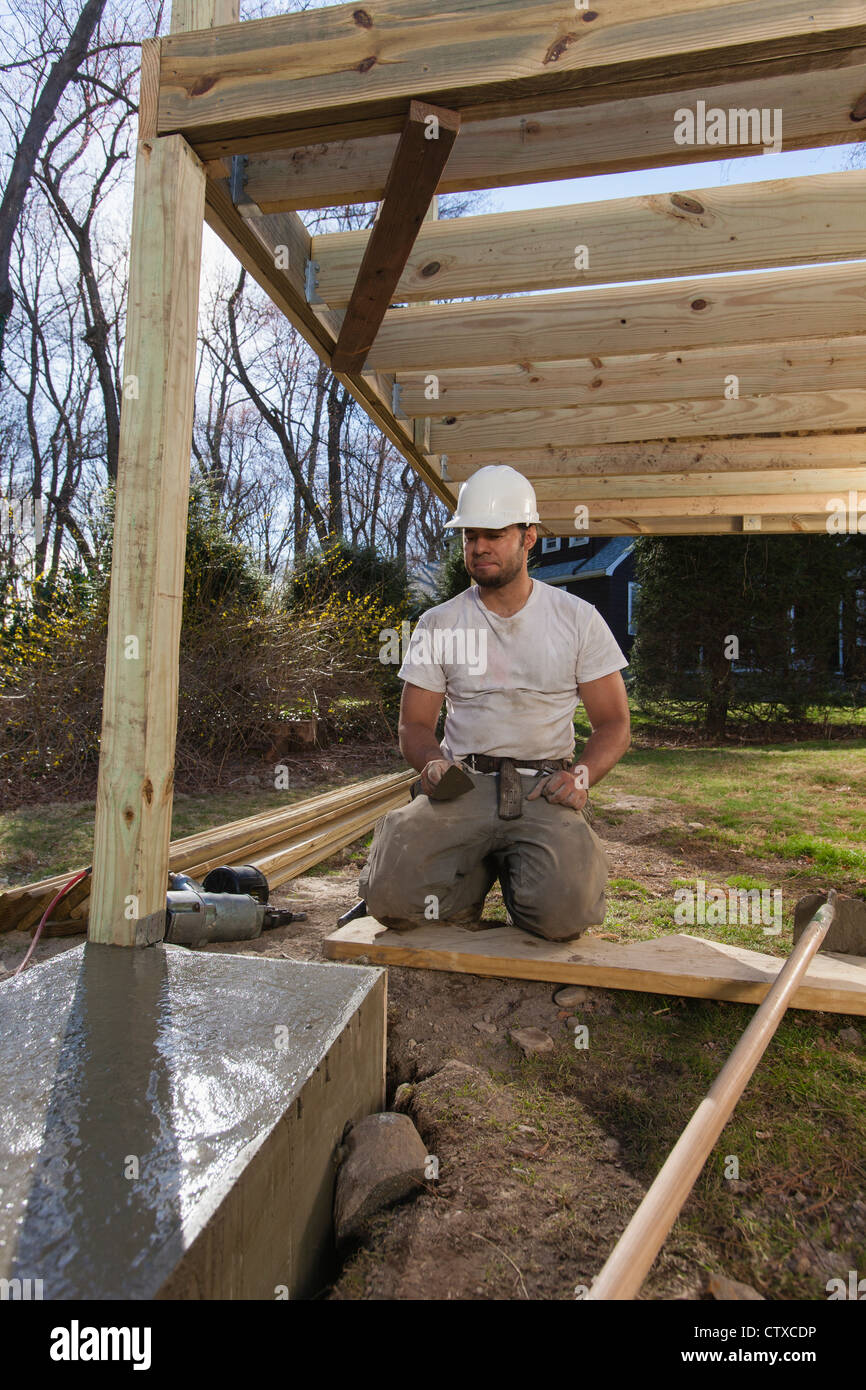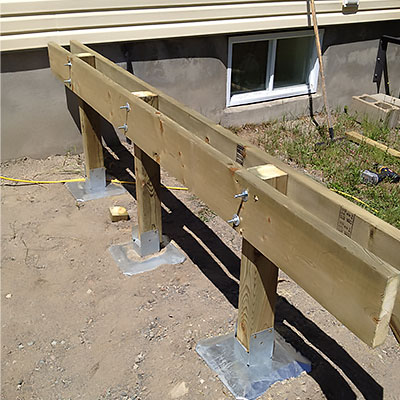Picking the Right Deck Footings for Security and Toughness
When it pertains to constructing a deck, one of the most important decisions you will make is picking the best grounds for stability and durability. The long life and security of your deck depend heavily on the kind of footings you select, as they give the crucial support and security to endure the examination of time. With a myriad of options readily available, it can be frustrating to determine which grounds are best suited for your certain demands. In this conversation, we will certainly check out the numerous types of deck grounds, consider the crucial elements to weigh when choosing, and look into the benefits and drawbacks of various choices. By the end, you will certainly have a clearer understanding of the selections at hand and be better furnished to make an informed decision for your deck job.
Kinds Of Deck Footings
These footings consist of a round hole filled with concrete, which offers a solid foundation for the deck messages. Concrete pier grounds are relatively easy to install and offer excellent stability, making them a preferred choice for numerous deck jobs.
One more sort of footing is the helical heap ground. Helical piles are steel shafts with helical plates affixed to them. These grounds are mounted by screwing them right into the ground, which produces a safe structure for the deck. Helical stack footings are perfect for areas with challenging dirt problems, as they can be set up in practically any kind of dirt. If needed., they additionally enable for easy adjustment and leveling of the deck.
Additionally, some building contractors choose precast concrete footings. These grounds are made from resilient concrete and can be found in numerous forms and dimensions to suit different deck layouts. Precast concrete footings are hassle-free to set up and offer a steady base for the deck framework.
Finally, another alternative is the post-in-anchor footing system. This type of footing entails driving a steel support right into the ground and connecting it to the deck blog post. It uses versatility in regards to placing the deck messages and appropriates for decks with lightweight frameworks.
When selecting the best sort of deck footing, it is important to consider factors such as dirt problems, deck load, and regional building codes (Deck Footings). Consulting with a specialist specialist or architectural designer can aid make certain the suitable ground is selected for a stable and safe deck
Variables to Think About When Picking Footings
When choosing the suitable grounds for a deck, it is important to carefully take into consideration numerous variables such as soil conditions, deck tons, and adherence to regional building codes. These aspects play a significant role in ensuring the stability and resilience of the deck structure.
The kind of soil on which the deck will be built establishes the type of footings needed. On the various other hand, decks developed on clay or extensive dirts may call for footings that can suit the soil's tendency to expand and agreement.
An additional important element is the deck lots. The weight of the deck, including the materials utilized and any potential real-time loads such as furnishings or celebrations, must be taken into account when choosing grounds. The grounds need to be made to birth the weight of the deck and distribute it uniformly to avoid any architectural problems or failures.
Last but not least, adherence to regional building regulations is extremely important. Building ordinance vary from area to area, and it is important to adhere to the specific requirements set by the regional authorities. Deck Footings. These codes ensure that the deck is constructed safely and meets the needed criteria for structural integrity and load-bearing capacity
Concrete Grounds: Pros and Cons

Concrete footings provide numerous benefits and drawbacks when made use of as the structure for a deck. On the silver lining, concrete grounds provide excellent security and resilience. Concrete is a inflexible and solid material that can support heavy tons and hold up against various climate condition. It also has a lengthy life-span, making it a trusted selection for lasting use.
An additional benefit of concrete grounds is their adaptability. They can be poured into various sizes and shapes to fit different deck layouts and arrangements. Concrete footings can be tailored to fit the specific demands and needs of the deck structure.
Nevertheless, there are additionally some downsides to using concrete grounds. This can enhance the general expense of the deck project and might require expert aid.

Helical Piers Vs. Sonotubes: Which Is Better?
In taking into consideration the structure alternatives for a deck, the contrast in between helical piers and sonotubes is important in determining the exceptional choice. Helical piers, likewise known as screw piles, are steel shafts with helical plates affixed to them. They are turned into the ground making use of hydraulic machinery, supplying a resilient and steady foundation for the deck. On the other hand, sonotubes are cylindrical kinds constructed from cardboard or fiber material that are my latest blog post full of concrete. They are put in a hole went into the ground and provide assistance for the deck.
When it concerns stability and durability, helical piers have the top hand. The helical plates on the piers produce a strong grasp with the soil, shifting or preventing any kind of motion of the deck. This is particularly helpful in areas with unpredictable or moving soil conditions. Sonotubes, on the other hand, depend only on the concrete filling up for stability, which might not provide the very same degree of strength and resistance.
In terms of setup, helical piers are reasonably simpler and faster to install contrasted to sonotubes. The hydraulic equipment used to twist the piers right into the ground makes certain a fast and reliable procedure. Sonotubes, on the other hand, need digging holes and pouring concrete, which can be time-consuming and labor-intensive.
In addition, helical piers are an even more versatile choice. They can be utilized in numerous dirt problems and can be readjusted or enhanced if required. Sonotubes, on the various other hand, may need extra assistance, such as rebar, in specific dirt problems or areas with high tons requirements.
Choosing the Right Footings for Your Deck's Measurements
For optimum structural honesty, it is necessary to very carefully select the proper grounds that straighten with the dimensions of your deck. The measurements of your deck, including its width, length, and height, play a substantial duty in determining the type and dimension of footings required.
When selecting footings for your deck, it is very important to consider the load-bearing ability of the dirt. The weight of the deck, incorporated with the weight of any kind of furnishings or people on it, exerts a substantial pressure on the grounds (Deck Footings). It is critical to select footings that can adequately sustain this weight without moving or sinking over time.
Bigger decks with greater dimensions need bigger footings to offer enough stability and assistance. The form of the footings, whether they are square or rounded, depends on the style and format of the deck.
Conclusion
In verdict, selecting why not try these out the ideal deck grounds is critical for making sure stability and durability. Elements such as the type of footings, the deck's dimensions, and the pros and disadvantages of different alternatives need to be considered.
These footings consist of a cylindrical hole loaded with concrete, which gives a solid foundation for the deck blog posts. Concrete pier footings are fairly very easy to mount and supply excellent stability, making them a popular selection for lots of deck projects.
Precast concrete grounds are convenient to install and offer a stable base for the deck framework.
It provides flexibility in terms of positioning the deck posts Clicking Here and is suitable for decks with light-weight frameworks.
Concrete footings provide a number of advantages and downsides when made use of as the foundation for a deck.